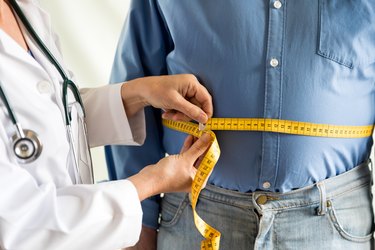
Obesity is more prevalent than ever in the United States. In fact according to the Centers for Disease Control and Prevention (CDC), about 40 percent of Americans are obese.
We know that obesity is linked to serious health risks, including heart disease, stroke, pregnancy complications, osteoarthritis and type 2 diabetes, per the National Institute of Diabetes and Digestive and Kidney Diseases. "Also, obesity results in an increased risk of mental illness, including anxiety and depression," says McKenzie Flinchum, RD, LDN, CPT, a CrossFit Games athlete and owner of The Flexible Dietician in Vero Beach, Florida.
Video of the Day
Video of the Day
But how exactly is obesity diagnosed, and what percent body fat is considered obese?
A Note on Language
Here at LIVESTRONG.com, we try to use inclusive language when it comes to sex and gender. Some weight-loss and body-fat percentage guidelines distinguish between women and men, but weight guidelines are usually more accurate when tailored to a person's individual calorie needs, activity level and overall health.
Still, we understand many people look up this information in relation to their own sex and gender, so we have used the words "woman" and "man" throughout this article.
Diagnosing Obesity
While the causes of obesity are somewhat complicated — an unhealthy lifestyle can cause obesity, but genetic factors also play a role, per the CDC — identifying the disease is a bit more straightforward. There are several measures that can determine whether or not someone has clinical obesity.
BMI
A crude measure of obesity is a person's body mass index (BMI), which is his or her weight (in kilograms) divided by height (in meters) squared. According to the World Health Organization, a person with a BMI of 30 or more is generally considered obese. The major drawback to BMI is the equation's inability to take muscle mass or frame size into account.
Waist Circumference
According to the Obesity Medicine Association, the circumference of one's abdomen at the largest point "is a measurement of central adiposity and correlates well with metabolic disease risk." The measurements indicative of obesity are: 40 inches or greater for Caucasian males; 35 inches or greater for Caucasian females and Asian males; and 31 inches or greater for Asian females, per the Obesity Medical Association. Of course, this determination is reliant on an accurate measurement.
Body Fat Percentage
This is the most accurate means of assessing obesity, as this kind of body composition testing takes frame size, muscle mass, sex and age into account. However, according to the Obesity Medical Association, it "is more limited in assessing for metabolic disease risk than abdominal circumference."
It is quite difficult to determine your body fat percentage accurately at home, but testing is available in clinical and professional settings. Per the Obesity Medical Association:
- Males: 25 percent or higher body fat indicates obesity
- Females: 32 percent or higher indicates obesity
Managing Overweight and Obesity
If you want to avoid obesity, your best bet is to be proactive. Eating a nutritious diet — avoiding processed foods, relying on fiber- and nutrient-rich options instead — is an obvious first step. Becoming less sedentary will help as well. According to the American College of Sports Medicine, a person trying to prevent obesity will be most successful if they commit to at least 150 minutes of moderately intense exercise per week.
Those who already have overweight can definitely see health benefits from starting a fitness plan. However, people with overweight have special considerations when exercising. For instance, they have an increased risk of orthopedic injury when participating in activities that put pressure on joints, muscles and connective tissue.
"A good place to start is to check with a doctor to determine if it is safe to begin exercise and to what extent," Flinchum says. "Once cleared for exercise, it is important to ease into new activities."
Flinchum recommends low-impact exercises, such as stationary biking, walking and swimming a few days per week: "Simply increasing movement is usually a great first step."
- Centers for Disease Control and Prevention: "Adult Obesity Facts"
- World Health Organization: "Obesity"
- National Institute of Diabetes and Digestive and Kidney Diseases: "Health Risks of Overweight & Obesity"
- Centers for Disease Control and Prevention: "Behavior, environment, and genetic factors all have a role in causing people to be overweight and obese"
- Obesity Medicine Association: "Definition of Obesity"
- American College of Sports Medicine: "Physical Activity: A Key Lifestyle Behavior for Prevention of Weight Gain and Obesity"
- Mayo Clinic: Obesity
Is this an emergency? If you are experiencing serious medical symptoms, please see the National Library of Medicine’s list of signs you need emergency medical attention or call 911.